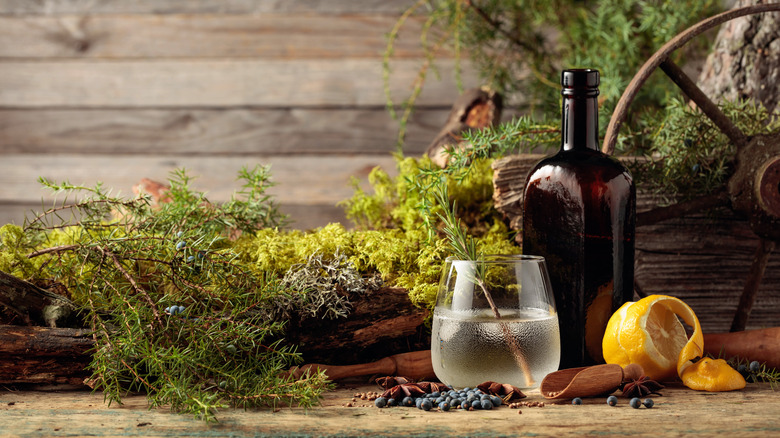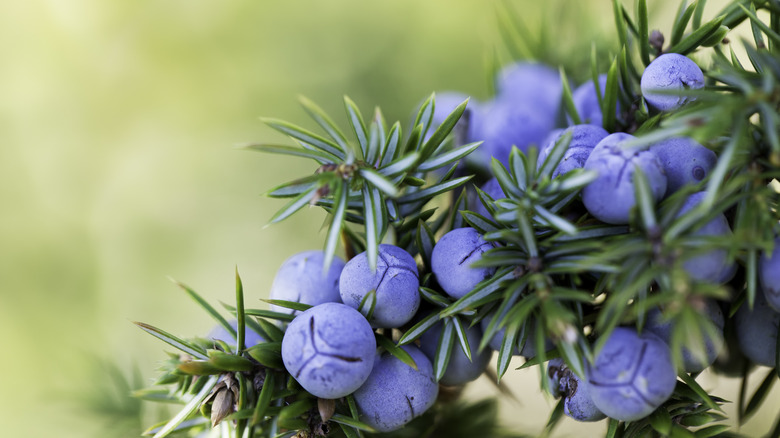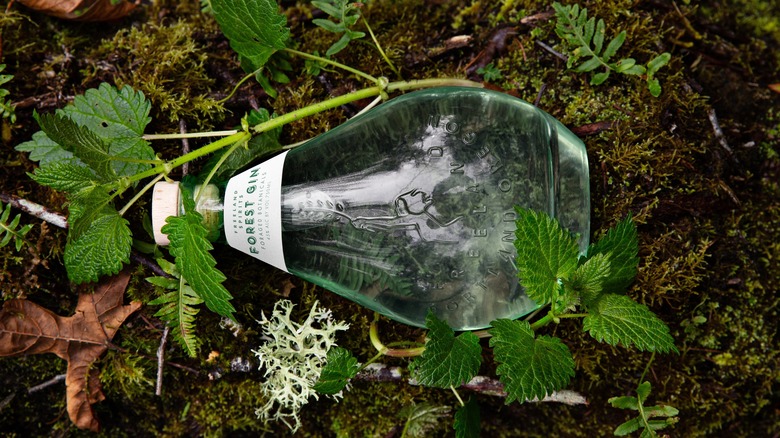The Main Ingredient That Gives Gin Its Herbal Flavor
Part of what makes gin such a distinctive, yet versatile spirit is its botanical flavorings. Most gin starts out with a base similar to vodka, essentially a neutral grain-based spirit, before it's flavored with a variety of herbs and plants to make it taste herbal, floral, and complex. The most popular of these botanicals — and the only one that gin producers are required to use — is juniper.
Juniperus communis, or common juniper, is an evergreen tree native to Europe, North America, and parts of Asia. This is why gin can be made in so many different places, and can carry such varied flavors. To call your spirit "gin," the only botanical you need is juniper, and a reliable source for it. The rest of the botanical flavoring mix is up to individual producers, and many brands keep their recipe a secret.
Juniper berries, the part of the plant that is used in gin, have a flavor reminiscent of pine, but with additional citrus-like notes. It is used as an ingredient in many dishes in Scandinavian cuisine, but its place in alcoholic beverages comes from the Dutch, who originally used it in a wine-based spirit called genever (whose name comes from the Dutch word for juniper, jeneverbes). The British took inspiration from genever to create gin, and to this day, London Dry gin is still the variety with the highest concentration of juniper flavor.
What else is in your gin?
Juniper didn't start out as a well-respected, essential part of gin. Historically, the distinctive flavor of the berries were used to flavor gin that was cheaply- or poorly-made. Even though we now have more reliable methods for making high-quality gin, the flavor of juniper has become a defining asset. It typically makes up about 60%-of the botanicals in most formulas for gin.
Coriander seeds are the second most-used botanical in gin, making up about 30% of most mixes. This powerful spice adds a bright, citrusy flavor and a peppery undertone. Whatever room isn't taken up by juniper or coriander is for gin distillers to get creative. Angelica root, with its bitter, earthy flavor, is also a popular botanical for gin, and many brands include some variety of citrus peel to add more brightness and sweetness.
London Dry gin (like Tanqueray and Bombay Sapphire) is more juniper-forward than other gins, and when a classic cocktail asks for gin, it's usually assumed that you'll use this type. The strong juniper notes can cut through other heavy-hitting flavors, such as the Campari in a Negroni. It's worth keeping in mind that gins with more complex and subtle botanicals may not be as easy to appreciate in complex drinks like this, so try them in a gin and tonic, or even straight up.
Local botanicals, global brands
A good gin is categorized by a balance between its ingredients. A single bottle can contain as few as four botanicals, or as many as fifty. Other popular botanicals in gin include licorice, orris root, star anise, cassia, and cardamom, but modern distillers often branch wildly out of these classic choices, with excellent results.
Many gin brands today are turning to local botanicals to make varieties of gin that capture the essence of a particular place. Freeland Spirits in Portland, Oregon processes locally-grown botanicals like chanterelle mushrooms, nettles, salal berries, and douglas fir tips to make their Forest Gin taste like the nearby Forest Park.
Gin Mare, a Mediterranean-based gin company, uses ingredients sourced from the Mediterranean coast, like the arbequina olive, thyme, rosemary, and basil, to create a unique, geographic flavor profile. And the African gin brand Bayab Gin uses the citrusy baobab fruit as its prime botanical to give their spirits a uniquely African twist. The result is that you can now taste your way around the world in a martini — and while classic brands will never go out of style, exploring truly novel gins can be just as satisfying.



